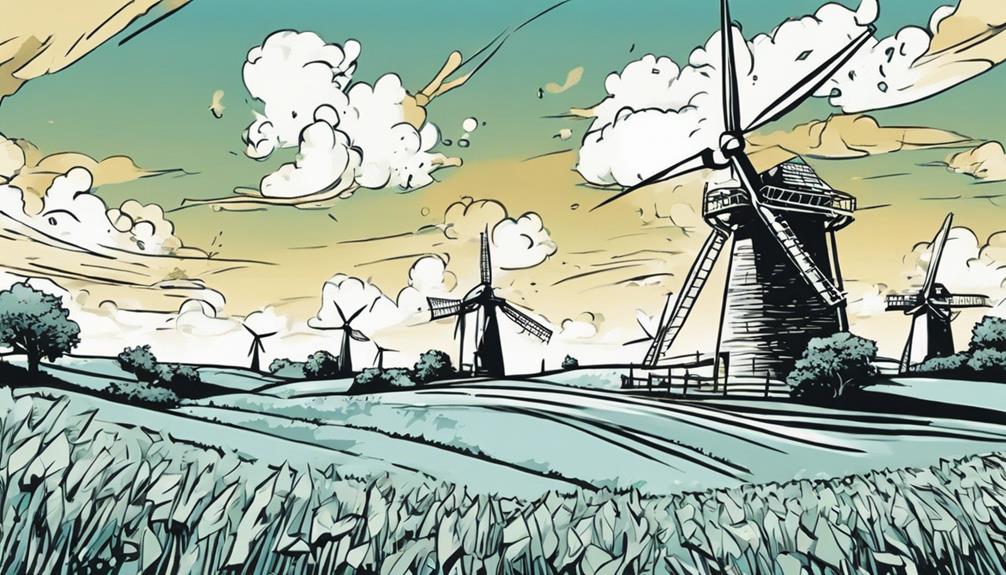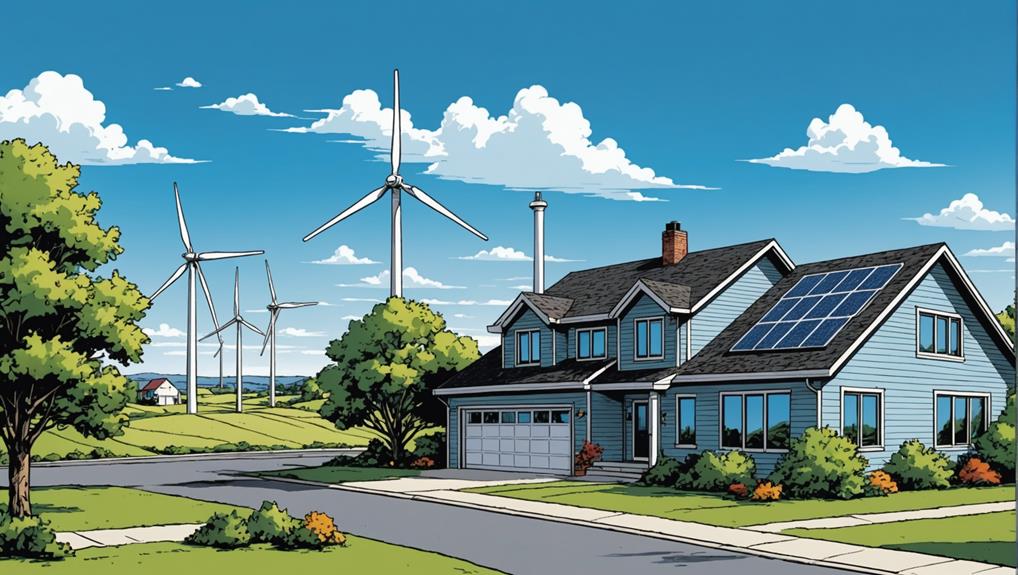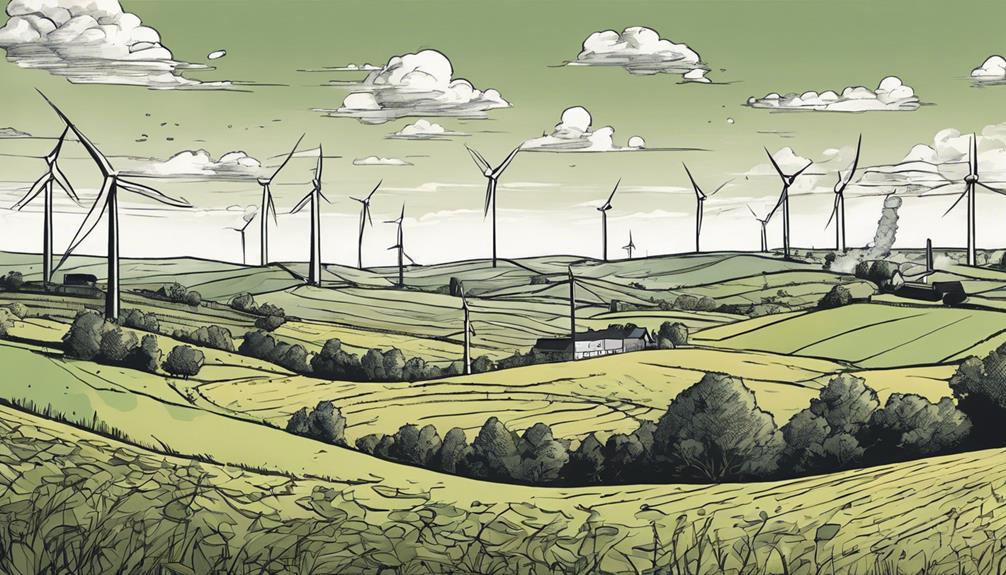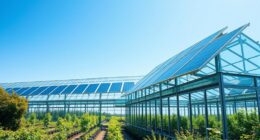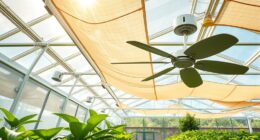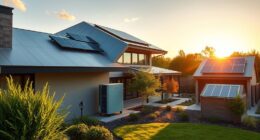Windmills, especially in wind farms, can change wind speeds and patterns nearby. They create a "marine braking effect," altering natural airflow. During hurricanes, turbines shut down to control wind impact. Offshore farms reduce wind speed and wave height, lessening storm damage. These effects show the intricate relationship between windmills and the atmosphere. Results suggest sustainable energy strategies for the future.
Key Takeaways
- Windmills can reduce wind speeds up to 70 km behind offshore farms.
- Turbines alter natural air flows and wind patterns.
- Wind farms demonstrate complex interactions with the atmosphere.
- Wind direction and speed changes occur near wind farms.
- Windmills can have varying effects on air quality and composition in their vicinity.
Marine Braking Effect
Studying the marine braking effect of windmills reveals significant insights into their impact on wind speed over water. Research conducted at Technische Universität Braunschweig and Karlsruhe Institute of Technology indicates that wind barely slows over water, but a reduction effect can be observed up to 70 km behind offshore wind farms. This phenomenon demonstrates long-lasting effects, especially under specific atmospheric conditions. Understanding the marine braking effect is essential for planning future offshore wind farms to optimize their efficiency.
The presence of offshore wind farms can lead to a notable decrease in wind speed, showcasing the influence of these structures on the surrounding environment. This reduction in wind speed behind wind farms highlights the complex interactions between the turbines and the atmosphere.
Wind Energy in Hurricanes

Wind energy in hurricanes presents an intriguing potential for mitigating storm intensity through the utilization of massive wind farms. These wind farms could play a pivotal role in reducing hurricane intensity by lowering wind speeds.
While current turbines shut down in wind speeds over 125 km/h, the prospect of using wind farms to decrease wind speed and wave height offers a promising strategy to mitigate hurricane damage. Studies indicate that under specific atmospheric conditions, wind farms can have a lasting effect on wind speed reduction up to 70 km behind offshore installations.
This suggests that harnessing wind energy during hurricanes could potentially help in minimizing the destructive power of these storms. Understanding the impact of wind farms on wind speed reduction is essential for optimizing the efficiency of future offshore installations and developing effective strategies to utilize wind energy in combatting the intensity of hurricanes.
Also Interesting Findings

You may find it intriguing that windmills have an impact on air and can cause changes in wind speed. Observing atmospheric effects resulting from windmill operation can provide valuable insights into their environmental footprint.
These findings shed light on the broader implications of wind energy utilization.
Windmill's Impact on Air
Research findings reveal intriguing insights into how windmills affect the air, shedding light on their impact on the surrounding environment. When windmills are in operation, they interact with the natural flow of air, influencing local air flows and creating both direct and indirect impacts on the atmosphere. The table below summarizes key points regarding the impact of windmills on air:
| Windmill Impact on Air | Description | Effects |
|---|---|---|
| Air Flows | Windmills can alter the natural flow of air in an area, | Changes in air pressure and temperature patterns may |
| potentially leading to disruptions in local wind | occur, affecting local weather conditions. | |
| Impact | The presence of windmills can have a noticeable impact | on air quality, with potential changes in particle |
| on the surrounding air quality and composition. | concentration and distribution. | |
| Wind | Windmills can harness wind energy, which may result in | a reduction in wind speed downstream of the turbines, |
| changes in wind patterns, and alterations in wind | direction near the wind farm. |
Wind Speed Changes
Understanding how windmills impact air quality also involves investigating the significant effects they've on wind speed changes, as recent studies have revealed fascinating findings in this area.
Studies have shown that large-scale wind farms can lead to wind speed reduction effects extending up to 70 km behind offshore installations. These wind speed alterations aren't just temporary but can persist under specific atmospheric conditions, affecting energy generation efficiency.
Moreover, it has been observed that wind speed barely slows over water, which magnifies the impact on wind speeds behind wind farms built in these locations.
Researchers from Technische Universität Braunschweig and Karlsruhe Institute of Technology have explored studying these wind speed reduction effects to understand the implications for future offshore wind farm planning.
Recognizing and comprehending the mechanisms behind these wind speed changes is essential for optimizing the design and placement of wind turbines to maximize energy generation while minimizing potential drawbacks on wind speeds in surrounding areas.
Atmospheric Effects Observed
Amidst the exploration of windmills' impact on wind speed alterations, intriguing atmospheric effects have been observed, revealing further insights into the interaction between wind energy and the environment.
When wind turbines are integrated into the landscape, they can influence atmospheric conditions in various ways, shaping the environment around them. Here are some key observations:
- Wind Turbines and Wind Speed: Wind turbines can cause a slowing of wind speed up to 70 km behind offshore wind farms, showcasing the significant reach of their impact on atmospheric conditions.
- Hurricane and Typhoon Intensity Reduction: Wind farms have shown potential in reducing the intensity of hurricanes and typhoons by moderating wind speed and wave height, demonstrating a unique benefit to the environment beyond energy production.
- Solar Energy and Energy Production: While wind energy plays a pivotal role, the significance of solar energy, particularly through solar thermal power plants, highlights the diverse approaches to sustainable energy production and the importance of considering multiple sources in the energy shift.
Concentrated Solar Power Benefits
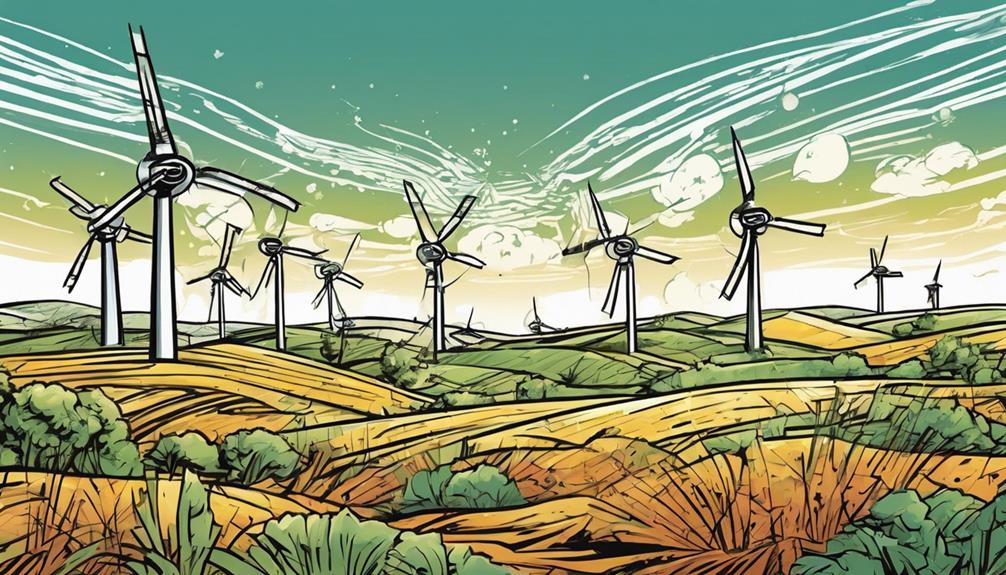
Solar thermal power plants offer high efficiency in energy generation by focusing sunlight to produce electricity. This method of harnessing solar energy is a crucial part of renewable energy production, markedly reducing carbon emissions and aiding in the shift to cleaner energy sources. The concentrated solar power (CSP) technology allows for the storage of excess energy, ensuring a continuous power supply even during periods of low sunlight. The benefits of concentrated solar power are apparent in its ability to provide sustainable energy while mitigating environmental impact.
To illustrate the advantages of concentrated solar power, consider the following table:
| Advantages of Concentrated Solar Power | Description |
|---|---|
| High Efficiency in Energy Generation | Produces electricity by focusing sunlight. |
| Storage Capability for Continuous Energy Supply | Stores surplus energy for use when sunlight is limited. |
| Key Role in Reducing Carbon Emissions | Plays a crucial part in sustainable energy production. |
Utilizing Waste Heat Efficiently

You can harness waste heat efficiently to warm homes and decrease energy usage. By implementing district heating systems and industrial processes, waste heat can be repurposed effectively.
This practice not only enhances energy efficiency but also contributes to reducing greenhouse gas emissions.
Waste Heat Utilization
With advancements in technology, waste heat can be efficiently utilized for heating purposes in homes, reducing energy consumption. Here are three key points to keep in mind about waste heat utilization:
- Energy Efficiency:
Recovering waste heat from processes like wind power generation and redirecting it for residential heating enhances energy efficiency by making use of otherwise wasted energy.
- Environmental Impact:
Waste heat utilization plays an essential role in sustainable energy practices, contributing to a greener environment by reducing the need for additional energy production and lowering carbon emissions.
- Resource Conservation:
Utilizing waste heat for residential heating not only reduces overall energy demand but also helps in conserving resources by maximizing the efficiency of energy production processes.
Innovative technologies are paving the way for waste heat recovery systems to notably reduce energy waste and enhance sustainability efforts. By harnessing this untapped resource, we can create a more efficient and environmentally conscious energy landscape.
Energy Efficiency Solutions
Innovative techniques for utilizing waste heat efficiently in residential heating systems have shown promising results in reducing energy consumption and enhancing sustainability efforts. Waste heat recovery plays a crucial role in sustainable energy practices by repurposing excess heat generated by various sources such as power plants. By harnessing this waste heat, homes can be heated more efficiently, thereby reducing the impact on the environment and lowering energy costs. This approach not only improves energy efficiency but also contributes to a greener future by decreasing carbon emissions.
| Waste Heat Utilization Benefits |
|---|
| Reduces Energy Consumption |
| Lowers Carbon Emissions |
| Enhances Sustainability Efforts |
| Decreases Energy Costs |
| Improves Environmental Impact |
Residential Heating Innovations
How can residential heating systems effectively utilize waste heat to improve energy efficiency and sustainability?
Innovative residential heating systems have the potential to harness waste heat efficiently, contributing to a more sustainable future. Here's how they achieve this:
- Waste Heat Recovery: By capturing excess heat from industrial processes or other sources, residential heating systems can repurpose this energy for heating homes, reducing the reliance on traditional fossil fuels.
- Energy Efficiency: Utilizing waste heat in homes helps decrease overall energy consumption, leading to lower utility bills and a reduced environmental footprint.
- Sustainability Benefits: Waste heat utilization not only provides a more eco-friendly heating solution but also aligns with sustainable energy practices, promoting a greener lifestyle and contributing to a healthier planet.
Global Impact and Future Considerations

Considering the global influence and future considerations of windmills, it's evident that their role in the shift to renewable energy is vital. In the United States, the integration of wind power has led to significant changes in the energy landscape, contributing to a reduction in CO2 emissions and helping address climate change challenges. The weather and climate effects of windmills are localized, with minimal long-term impact on global systems compared to traditional energy sources.
Looking ahead, the expansion of wind power capacity while mitigating environmental impacts remains essential for sustainable energy strategies. The shift to wind energy plays a pivotal role in reducing water consumption and addressing water scarcity issues on a global scale.
As the world increasingly adopts renewable energy sources, the long-term benefits of wind power outweigh any minimal effects on Earth's atmospheric energy. Emphasizing the importance of windmills in the renewable energy mix highlights their positive contributions to a greener future.
Wind Plant Atmospheric Effects
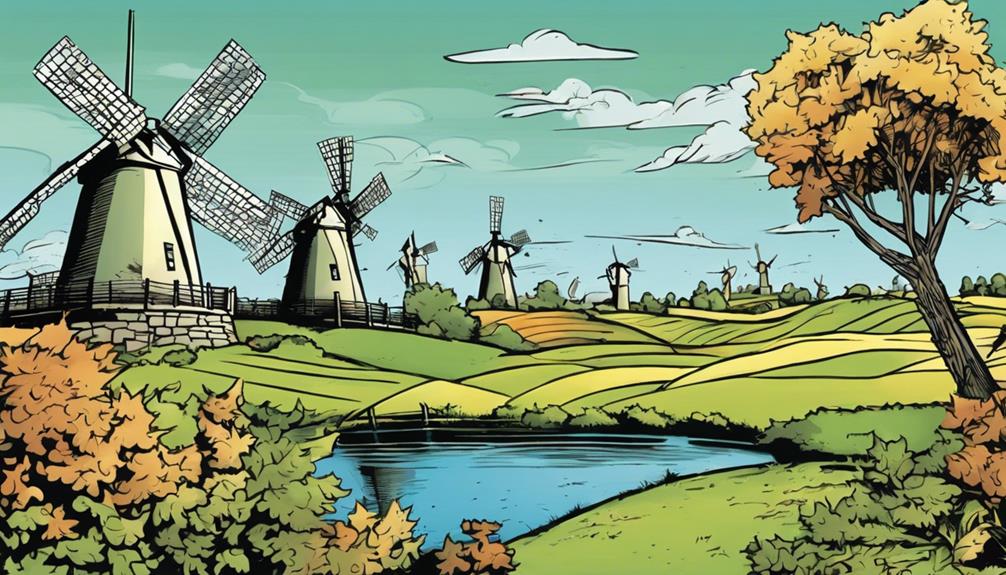
Wind plants create notable atmospheric effects, influencing wind patterns and turbulence levels in their vicinity. When wind turbines are installed, they induce changes in the wind flow that can have far-reaching consequences on the surrounding atmosphere.
Here are three key aspects to take into account:
- Wind Deficit Aloft and Speed Acceleration: Wind plants lead to a reduction in wind speed at higher altitudes and an increase in wind speed closer to the ground. This alteration in wind distribution can impact weather patterns and create wake effects that persist over long durations.
- Enhanced Turbulence Kinetic Energy: Within the wakes of wind plants, turbulence kinetic energy is significantly heightened. This increase in turbulence levels demonstrates the intricate atmospheric effects that wind farms can instigate, influencing local meteorological conditions notably.
- Role of Mesoscale Models: Utilizing fine-resolution mesoscale models is essential for accurately evaluating the impacts of wind plants on the surrounding environment. These models help in predicting the complex interactions between wind turbines and the atmosphere, aiding in better understanding and managing the atmospheric effects of wind energy installations.
The Environmental Impact of Wind Power
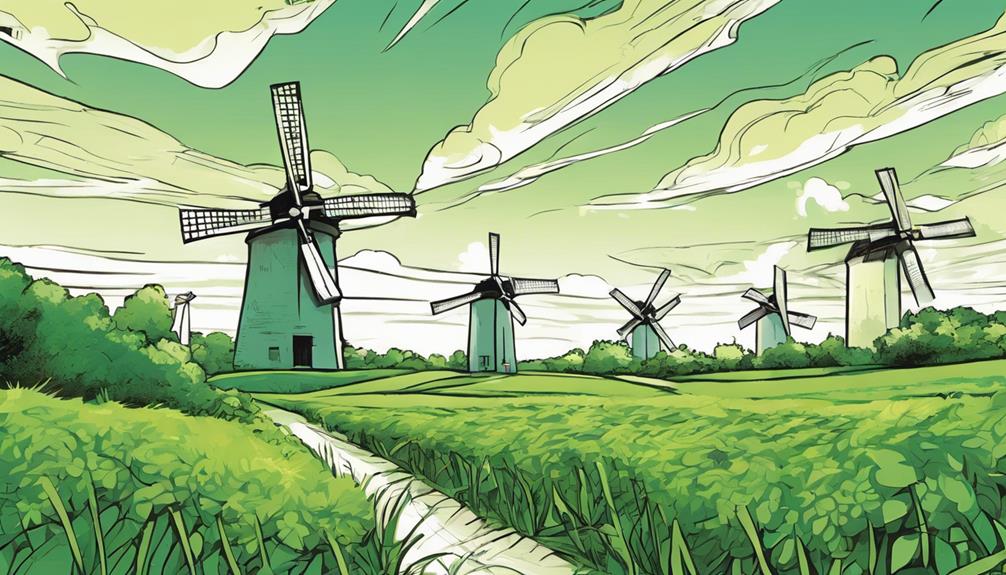
Harnessing wind power for energy generation may have ecological repercussions that need thorough examination. Wind plants, while producing clean energy, can also have a significant impact on the environment. The power generated by wind can disrupt natural air circulation, potentially altering local weather patterns.
Additionally, concerns arise regarding the impact of wind turbines on water flow, bird populations, and overall ecosystem stability. It's vital to conduct detailed calculations to quantify these environmental impacts accurately.
Balancing the need for sustainable energy sources with the potential consequences on the environment is essential for a successful shift to wind power. By understanding and addressing the environmental implications of wind energy, we can work towards a more sustainable future where clean energy sources like wind power play a significant role in reducing CO2 emissions and combating climate change.
Frequently Asked Questions
Do Windmills Cause More Wind?
Windmills don't generate more wind. They can slow down wind speeds behind offshore farms. Studies show turbines don't have a major impact on global weather. Turbines shutting down in high winds is essential. Understanding the marine braking effect is important for future projects.
What Are the Negative Effects of Windmills?
Understanding the negative effects of windmills is essential for sustainable energy planning. They disrupt local air movement, alter ecosystems, impact water flow, and require careful calculations to quantify their environmental impacts accurately on both local and regional scales.
What Is One of the Biggest Disadvantages to Wind Turbines?
One significant drawback to wind turbines is their potential to alter local atmospheric conditions, creating concerns about impacts on wind patterns and ecosystems. Studies are ongoing to evaluate these effects thoroughly for informed decision-making.
Do Windmills Produce More Energy Than They Use?
Windmills do produce more energy than they use. They have a high energy return on investment, with an energy payback time of around 6-8 months. Studies confirm that wind turbines generate more energy than their total lifecycle energy consumption.
How Does the Presence of Windmills Impact Wind Energy Production in the Power Grid?
The role of wind energy grid is crucial in harnessing the power of windmills. Wind turbines are strategically placed in areas with high wind speeds to maximize energy production. The presence of windmills can impact wind energy production by increasing the overall output of renewable energy in the power grid.
Conclusion
So, do windmills actually cause more wind?
While they may have some localized effects, the overall impact on wind patterns is minimal.
The benefits of wind energy, such as reducing carbon emissions and providing clean power, far outweigh any potential changes in wind patterns.
So, next time you see a windmill spinning in the distance, ask yourself: is harnessing the power of the wind worth it for a sustainable future?
